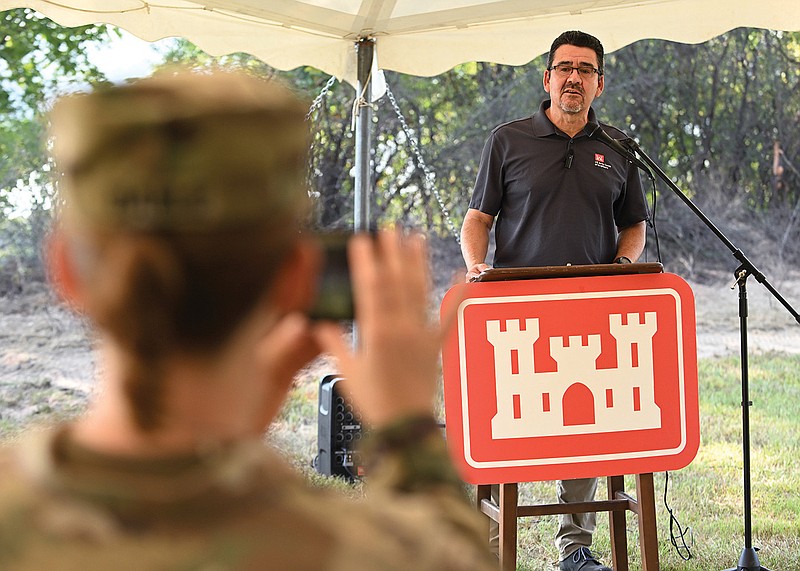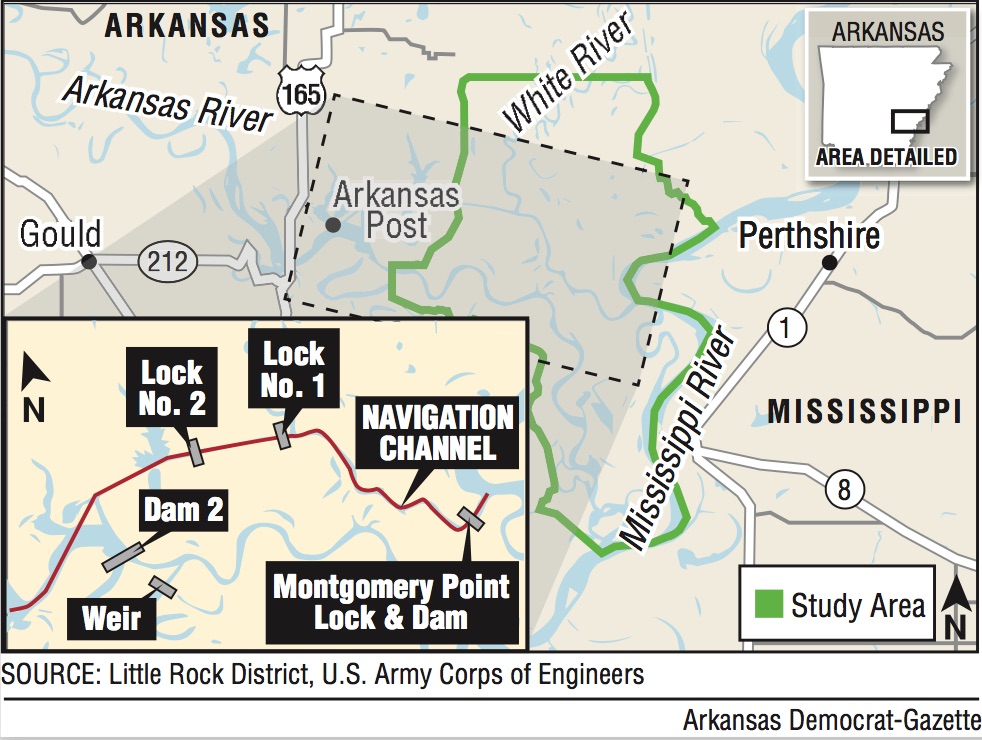The Little Rock district of the U.S. Army Corps of Engineers held a groundbreaking Thursday for the first phase of a project meant to keep traffic flowing along the McClellan-Kerr Arkansas River Navigation System.
Though the Three Rivers project event took place at David D. Terry Park just below Little Rock, the work itself will begin upriver from Montgomery Point Lock and Dam, the last such structure before the Mississippi River. It is intended to prevent the merging of the Arkansas and White rivers, protecting navigation along the system, according to Jay Townsend, spokesman for the Little Rock district.
The project is critical to the success of other projects along the navigation system, such as a massive effort to deepen the entirety of a 445-mile section of the Arkansas River to 12 feet.
"This is the linchpin," he said. "This is the project that's holding it all up."
If a breach occurred between the two rivers in the project area, navigation would halt for "extended periods" due to dangerous cross currents during high flows, as well as a loss of the navigation pool during low flows, according to the Corps.
If navigation along the system stopped for 100 days, the cost could be as heavy as $300 million in lost navigation benefits and commerce.
Roughly $3 billion in goods, or between 11 million and 12 million tons, are shipped on the system each year, Col. Damon M. Knarr, commander of the U.S. Army Corps of Engineers Little Rock District, said during the groundbreaking ceremony.
"A convergence between the White and Arkansas rivers would come at a catastrophic cost to the 12 states and five international ports this system serves," he said.
The project is divided into two phases, the first of which the Corps estimates will be completed in September 2026. Estimated completion of phase two will depend on timing and funding, though, Townsend said.
To fund the project, the Corps received $109 million from the Bipartisan Infrastructure Law. Townsend described the infrastructure law as "the once-in-a-lifetime funding bill" from President Joe Biden's administration that is intended to repair the country's aging infrastructure.
The Corps also received for the project $149 million from the president's budget, he said.
A major construction feature of the first phase involves development of an armored hydraulic weir at the site of the Historic Closure Structure, according to a project vignette provided by the Corps. With a crest elevation of 145 feet above the mean pool elevation, it is meant to preserve the navigation pool and allow water to flow between the two rivers without damaging erosion.
In the second phase, the Corps will develop a hydraulic containment structure at an elevation of 157 feet above the mean pool elevation. The Owens and LaGrues weirs will also be modified, according to the Corps. The work is also meant to prevent damaging flows.
"Rivers want to meander," Townsend said. "They've always moved before we were able to contain them, and the Arkansas and the White are still wanting to do that."
The containment structures currently in place aren't big enough, so the Corps intends to put additional culverts, structures and bridges to allow an equilibrium, so that if both rose at the same length, "there wouldn't be a fight to overtake one or the other."
Knarr said the structures to be developed through the Three Rivers project will increase the navigation system's resiliency. According to the commander, the project will also "reduce operations and maintenance costs by providing robust structures with minimal maintenance."
Michael Connor, assistant secretary of the Army for Civil Works, said during the groundbreaking that the project's ceremonial start was "worthy of celebration."
"It represents from my perspective what we're charged with, and what we're trying to accomplish with the Army Civil Works program," he said. "Right now, we are very focused on building new capacity with respect to infrastructure and building new protections for communities."
Connor said that, due to the continual changes the Arkansas and White rivers, like all rivers, undergo, projects on inland waterways will always be works in progress.
"Overall, we're never going to be one-and-done when we complete a construction project and move forward," he said. "We're constantly going to have to maintain it, and we're going to have to reinvest at significant levels."
During his speech at the ceremony, U.S. Rep. Rick Crawford, R-Ark. emphasized the navigation system's importance, calling it "a superhighway of economic impact."
"It's just staggering the amount of impact that MKARNS counts for," he said.
Crawford, who is a member of the House Committee on Transportation and Infrastructure, said that waterways are often given "short shrift," and said he hoped to make sure their value as part of the transportation world is highlighted.
Pulaski County Judge Barry Hyde agreed with Crawford's sentiments.
"A lot of folks in Central Arkansas don't realize the importance and the value of the river navigation system," Hyde said during an interview following the groundbreaking. "As well as the new deepening project to a 12 foot navigation."
The county judge said he hoped the Three Rivers project and the effort to deepen the river system would help to bring more employees to the region and further drive the region's economy.
Allison J. H. Thompson, president and CEO of the Economic Development Alliance for Jefferson County, said she was also at the event to celebrate efforts that would promote the resilience and well-being of the river system.
"What's good for the MKARNS is good for the Port of Pine Bluff," she said.
While Connor similarly described the event as a cause for celebration, he closed out his speech by looking to the future.
"Groundbreakings are great, but ribbon cuttings are even better, so I'll look forward to coming back at the appropriate time to do the ribbon cutting and celebrate the work that's been done," he said.

